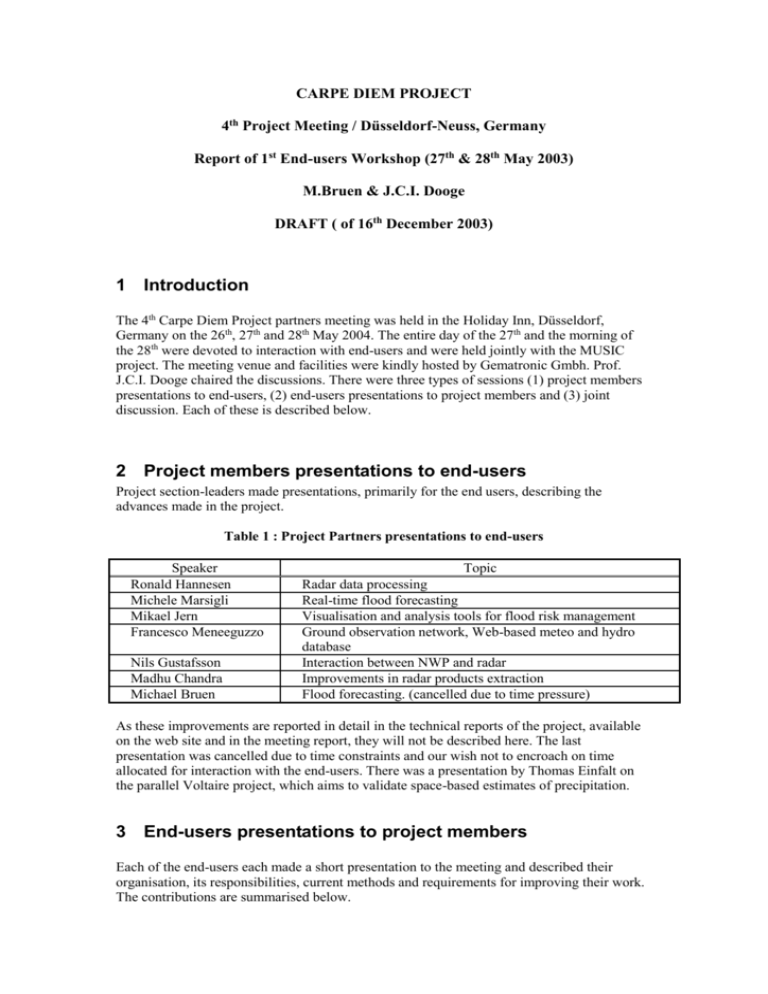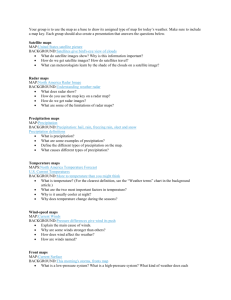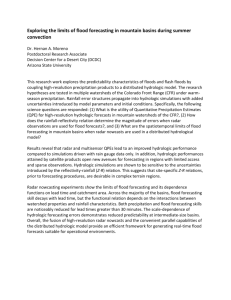2 Project members presentations to end-users
advertisement

CARPE DIEM PROJECT 4th Project Meeting / Düsseldorf-Neuss, Germany Report of 1st End-users Workshop (27th & 28th May 2003) M.Bruen & J.C.I. Dooge DRAFT ( of 16th December 2003) 1 Introduction The 4th Carpe Diem Project partners meeting was held in the Holiday Inn, Düsseldorf, Germany on the 26th, 27th and 28th May 2004. The entire day of the 27th and the morning of the 28th were devoted to interaction with end-users and were held jointly with the MUSIC project. The meeting venue and facilities were kindly hosted by Gematronic Gmbh. Prof. J.C.I. Dooge chaired the discussions. There were three types of sessions (1) project members presentations to end-users, (2) end-users presentations to project members and (3) joint discussion. Each of these is described below. 2 Project members presentations to end-users Project section-leaders made presentations, primarily for the end users, describing the advances made in the project. Table 1 : Project Partners presentations to end-users Speaker Ronald Hannesen Michele Marsigli Mikael Jern Francesco Meneeguzzo Nils Gustafsson Madhu Chandra Michael Bruen Topic Radar data processing Real-time flood forecasting Visualisation and analysis tools for flood risk management Ground observation network, Web-based meteo and hydro database Interaction between NWP and radar Improvements in radar products extraction Flood forecasting. (cancelled due to time pressure) As these improvements are reported in detail in the technical reports of the project, available on the web site and in the meeting report, they will not be described here. The last presentation was cancelled due to time constraints and our wish not to encroach on time allocated for interaction with the end-users. There was a presentation by Thomas Einfalt on the parallel Voltaire project, which aims to validate space-based estimates of precipitation. 3 End-users presentations to project members Each of the end-users each made a short presentation to the meeting and described their organisation, its responsibilities, current methods and requirements for improving their work. The contributions are summarised below. 3.1 Joan Bech (Catalan Meteorological Service, SMC) The Catalan Meteorological Service (SMC) is, since, 1996, a public company charged with civil protection. They currently have 180 automatic surface monitoring stations with raingauges and 2 weather radars (C-band Doppler) They expect to have 2 further radars in operation soon. The radars’ coverage includes all except a small part of northwest Catalunya with is very mountainous. They produce a rainfall analysis product using 54 stations at 30 min steps with a 15 min delay- spatial resolution is 0.1 x 0.1 degrees. Their radar has 6 min scans with a 2 min transmission delay. Their radar products are accumulated precipitation for 1, 6 and 24 hours using a fixed Z-R relationship, with a 3 min delay. They use it in conjunction with an NWP model for QPF for warnings with a lead-time up to 1 hour. They have different levels of warning . Level A is where 20 mm is expected to occur within a 30 minute period or 100 mm within a day. Level B is when 40 mm/30 min or 200 mm/day is expected. Their problems are beam blockage and beam overshooting. They use radar only qualitatively. They would like (I) “real-time” precipitation accumulations (with a lead time of 1 hour); (ii) offline verification of their NWP-QPF estimates.(iii) produces suitable for urban hydrology, (iv) hydrological models for regional water management (would be used by the Catalan Water Agency- Joan to approach them to join end-user panel) They need an enhanced system for QPF with more frequent predictions and with a quality indicator accompanying the forecasts. They are involved in a related project which addresses the problems of ground clutter identification and removal; beam blockage; bright band; attenuation; and VPR correction. 3.2 Mireia Fageda I Bertra (CLABSA) CLABSA’s main mission is to avoid flooding of Barcelona and prevent sewerage contamination of the Mediterranean. Barcelona has a combined sewer system with a total pipe length of 1650 km and with a storage capacity of 2634124 m3 . They manage the runoff from 31 catchments with a total area of 123.26 km2 which is 90% urbanised. Average annual precipitation is 600 mm. They have problems when they get over 150 mm in an hour or over 37 mm in a 15 minute period and would like to be able to forecast these extreme events. They have access to data from 3 radar systems (I) National Institute (INM) (ii) SMC and (iii) Furuno radar (old). In addition they are responsible for the management of the Besos river park. This river has a catchment of 1024 km2. They would like (I) more accurate precipitation products, (ii) better prediction and (iii) better visualisation. 3.3 Luca Rossi (Civil Protection, Italy) Luca Rossi’s organization is responsible for detecting and warning of the approach of storms and also for planning for and preventing catastrophies. They forecast using NWP, radar and rainfall/runoff models. They monitor the progress of flood events to support emergency management. They have 9 Doppler C-band radars, 3 new polarimetric Doppler C-band radars and access to data from 4 military units operated by the Italian Air Force. They wish to improve the accuracy of warning systems and especially to reduce the incidence of false alarms because of (I) the loss of credibility and (ii) the cost. Some related problems they have are logistical, no natural data management structures or defined standards for data management. Their technical problems related to (I) coverage, (ii) beam blockage, (iii) beam attenuation and (iv) clutter. They expect, within three years, to take part in a National network made up of 21 decentralised functional units. Their current use of radar includes surveillance, monitoring the spatial distribution of precipitation and the movement and variation in intensities of rainstorms. They would like better integration with real-time rain gauge systems. They Require: (i) A national radar mosaic (to deal with beam blockage and radar failures) (ii) Sharing development of information systems (iii) Decluttering techniques (iv) QPE improvement for use in rainfall runoff models (v) Use of automatic or, at least, semi-automatic models (vi) Data quality indices (vii) Ability to monitor volcanic ash (viii) 4 to 10 hours lead times 3.4 Peter Calla (Sweden) Peter Calla represents the Hydropower industry in Sweden. His catchment of interest has an area of 120,000 km2. Their main duties are to construct and manage plants to regulate water flows, i.e. water management, dam safety, insurance. They use the HBV catchment model with a daily time step. They generally have good performance, but not completely reliable for flood events. They require better estimates of the precipitation pattern. 3.5 Kannu Puramen (Finland) Kannu Puramen works for Kemijoki Oy whose main concern is hydropower generation. They have 16 plants and manage over 50,000 km2 of catchments. They use the Finnish version of the HBV model and optimise the operation to minimise spillway losses. They would like forecasts of 1 hour precipitation accumulations after 1 hour processing and accurate forecasts up to 3 hours. They are currently testing the combination of rainfall and radar estimates of precipitation. The Finnish Roads authority is mostly concerned with snowfall and has a team working with FMI. 3.6 Jan Stzurc (IMGW, Poland) The lessons from the Odra flood of 1997 are being applied to develop new forecasting systems. These involve 8 Doppler radars and the use of Mike-11 as a rainfall-runoff model. 3.7 Paolo Burlando (ETHZ, Switzerland). Prof. Burlando described the ETHZ experience with the forecasting system for the Maggia River catchment. This involved hourly rainfall forecasts based on radar and applied to 9 subcatchments. A complicating factor is the effect of the hydro-power plants themselves. Enduser requirements include the need for information in real time. He identified the following specific problem characteristics: • The torrential characteristic of the floods. The flood response varies, but can be within a few hours of the precipitation. This requires a model with a short, and ideally no, calibration period. • • • Very steep hill-slopes bounding narrow valleys. Several lateral tributaries at risk for erosion reach directly the main rivers. Requires a model with a detailed hydraulic structure able to make predictions for any point on any channel Steep topographical gradients also influence the different seasonal responses of the catchments to similar rainfall events. This requires an hydrological model capable of distinguishing dynamically between rain and snow precipitation and between snow melt and snow accumulation processes on the ground. Local effects due to rainfall variability and topography cannot be detected. Requires distributed catchment models to represent the spatial heterogeneity of catchments and processes. 3.8 Norbert Demuth (LfW) & Manfred Bremicker (LfU, Hochwasser central) They use the LARSIM (Large Area Runoff Simulation Model) on a 1 km by 1 km scale and use QPF up to 24 hours in advance. They found systematic spatial variations in the QPF estimation. They are involved in projects RADOLAN (with DWD), RADVOR-OP (using Lokalmodel), INFERNO (combining rain and radar estimates and satellite information) and RADOMET They require: (i) (ii) (iii) (iv) (v) 3.9 More accurate radar data, addressing the problems of bright band, anomalous propagation and VRP correction. More accurate NWP at 2.8 km resolution up to 48 hours lead time. Improved nowcasting Technologies which can be integrated into operational services. Real dialog between scientists and users. Rahman Khatabi (Environment Agency –UK) The Environment Agency is charged with issuing flood warnings in England and Wales and has a 2 billion euro program. This includes a 3 million euro programme on public awareness, including staged warning codes (watch, flood, severe, all clear). They have specific problems with: (i) Proliferation of many different systems and practices. So integration of modeling and forecasting systems is required. (ii) Model selection lacks scientific basis (iii) Lots of ad-hoc elements in models (iv) No minimum standards for modelling, nor generic performance criteria (v) Calibration is insufficient (vi) How to identify bad performance (vii) Many models inadequately documented and lack guidelines (viii) No feedback to modellers (ix) Models reside in systems that are neither open nor easily transferable. (x) Models must include a deterministic forecast, updating and uncertainty. 3.10 Geoffrey Pegram (University of Natal, SA) Has been extensively involved in various projects, including the “string of beads model”, nowcasting using radar and SIMAR (Spatial Interpolation and Mapping of Rainfall with 24 hours updates) Uses SBM model, 3-reservoir model, HMS and HECRAS. Requires increasing the forecast lead time for smaller catchments (perhaps using Kalman filter and MISP) Recommends the use of water games simulation to practice dealing with emergencies. 3.11 Sandro Nanni (ARPA-SMR) ARPA-SMR is involved in real-time, short and medium term forecasting for Civil Protection and Flood Warning as well as providing data for water resources management activities and studies. In the Emilia-Romagna region there are a large number of different agencies, both public and private involved in hydrological data collection. Has identified the following weakness in the current system. (i) (ii) (iii) Incomplete coverage Maintenance differences/difficulties Data not shared in real time They are currently implementing a project, RIRER, to integrate the data collection, equipment maintenance and data dissemination activities for the Region, Table 2. The planned raingauge density is 1 per 10 km2. Table 2 Situation in Emilia-Romagna Region & Project RIRER Pre- 2001 To be added in 2001-2004 Post 2004 Rain-gauges 111(33) 89(27) Water level 100 49 Totals 211 138 200(60) 149 349 * parentheses indicate the number of rain-gauge locations which are also meteorological stations 4 General Discussion: The individual presentations described in Section 3 above were followed by a general discussion. The following points were raised during this wide-ranging discussion. They are listed here, in the first instance, chronologically and are summarized in the following Section. A. Lead-time requirements depend on particular case and in particular on (i) the potential for loss of life and/or material damage (vulnerability), and (ii) the protection / mitigation measures available. An important consideration is the trade-off between lead-time and uncertainty in the forecast. B. An estimate of uncertainty should accompany all information, products, forecasts etc. This could be achieved by (i) doing ensemble forecasting and reporting upper and lower limits are sell as central tendency and variances, or (ii) using a full Bayesian analysis to estimate the posterior probability distribution, from which uncertainty measures could be derived. C. Generic tools are needed by end-users to deal with the requested uncertainty information. D. Due consideration should be given to the highly skewed nature of people’s perception of and response to risk. Most people are highly risk averse. E. A demand for an improved quality of radar product was common to at least 3 enduser presentations. F. Public education and training of emergency response personnel about how to cope with and interpret false alarms. This could include case-studies, post-hoc event analysis and should involve local communities (e.g. in Poland after the 1997 Odra flood). Training must be tailored, i.e. specific to special features and problems in specific regions. G. If real-time rain-gauges are provided at a density of 1 per 10 km2 do we still need radar? The answer is yes because of (i) complex orography (ii) 3 dimensional picture (much more than 2-d on the ground) and (iii) problems with rain-gauges in very cold weather. H. Some tools for better visualization of the information needed. I. Some discussion of MAP approach to end-users (Andrea Rossa) and difficulties in identifying them and establishing common language. Ultimately the end-user is the general public. J. Gap between those issuing forecast and those using it is large, need to increase informal communication between these people. Also for standard data formats and exchange systems K. Flood protection is only one aspect of water management. Others such as droughts, recreation and ecological effects should be considered. L. Appropriate information technology for field personnel (PDAs, radios etc.) M. Appropriate technology for communication with the public (e.g. web-site as in Sweden) N. Suggestion of a workshop with end-users to establish a common language. O. Project should produce a glossary of terms with clear explanations. P. Provide intensive courses for those responsible for flood forecasting Q. More national meetings between meteorologists/hydrologists and end-users R. There should be a document reflecting this workshop. 5 Summary 5.1 Organisation The combination of the end-users workshop with the MUSIC project provided the benefit of the combined numbers of end-users and participants/partners from both MUSIC and CARPE DIEM. On the other hand, the large numbers required a more formal approach to the organisation of the meeting, with chaired sessions and allocated time slots. This allowed both partners and end-users to present material about their work so that each can appreciate what the other is trying to do. Now that the formal introductions and familiarisation has been accomplished, further interactions with the endusers can be on a more informal basis. 5.2 Main recommendations from Dusseldorf meeting There is a need for 1. Improvement in the quality of radar and NWP information, including spatial and temporal resolution and lead-time for forecasts. Specific requirements vary between organizations and applications. 2. Uncertainty/Quality information to accompany data. 3. Training on how to interpret data and quality information and how to integrate quality information into operational systems and other forms of decision-making. 4. Study of false alarm implications on public perceptions, response, the credibility of the warning agency. This should feed back into the design of appropriate data for warning systems. 5. More communication (many possible forms suggested, e.g. training courses, “simulator” training, visualization tools, national meetings, production of a “glossary”) between data producers and end-users. 5.3 Suggestions Bring forward date of second workshop to middle of 2004 (to allow time to react to any further suggestions) Organise meeting informally, e.g. using Metaplan (to encourage dialogue)







